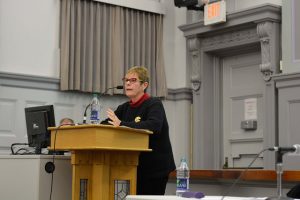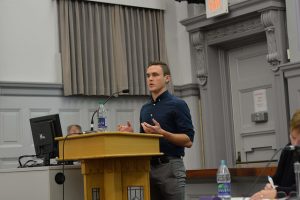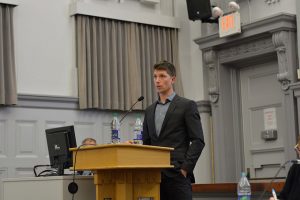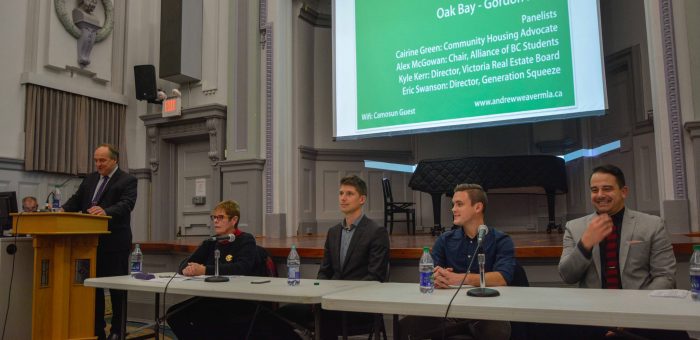Highlights from Housing & Affordability Town Hall
October 21, 2016 By Sarah Miller Comments are Off Affordability, Community Blog, Housing, Local Government, Social Development
I would like to extend my sincere thanks to everyone who attended and participated in our recent Town Hall on Housing and Affordability. We were lucky to have a diverse range of panelists bring their own perspectives and insights to our discussion about the complex challenges facing our housing market. In the Q&A period following the presentations, audience members provided their personal perspectives on how the housing and affordability crisis has affected them, asked a number of insightful questions and offered some creative potential solutions. It was a lively and informative discussion.

Cairine Green, a Community Housing Advocate and volunteer Board Director for Our Place Society, spoke about some of the causes and the effects of the housing and affordability crisis in Victoria and across the Province. The BC Non-Profit Housing Association defines affordable housing as requiring 30% or less of gross household income (in 2012); two other factors are suitable housing, where there are enough bedrooms for the size and make-up of occupants, and adequacy, where a home does not require major repairs. Increasingly, fewer and fewer people in Victoria live in housing that meets these criteria. Cairine highlighted the importance of affordable housing in maintaining healthy and sustainable communities, and the concerns of low-income seniors who want to be able to stay in their homes as they get older. She outlined the actions that municipalities can take to stem the tide of rising housing costs, and the need for different levels of government to work together to implement solutions.
 Alex McGowan, Chairperson of the Alliance of BC Students and President at the Kwantlen Student Association, emphasized the challenges facing students looking for housing, as well as the steps that Universities can take to address student housing needs, thereby benefitting the rental market more widely. His comments were supported by Maxwell Nicholson, Director of Campaigns & Community Relations from the UVic Student Society who was also in attendance.
Alex McGowan, Chairperson of the Alliance of BC Students and President at the Kwantlen Student Association, emphasized the challenges facing students looking for housing, as well as the steps that Universities can take to address student housing needs, thereby benefitting the rental market more widely. His comments were supported by Maxwell Nicholson, Director of Campaigns & Community Relations from the UVic Student Society who was also in attendance.
In the last ten years, the number of full-time students in B.C. has steadily grown and the number of international students has nearly doubled, yet very few new residence spaces have opened. There is a high demand for student housing: the Alliance of BC Students estimates that Universities in BC need to double their stock of student housing to meet the need. In 2014/2015 there were 10,900 students on waitlists for campus housing in B.C., nearly 3,000 of which were on the UVic list alone. Student housing is cheap to build, and would play an important role in easing the pressure on the rental market, creating space for those who may be currently in unaffordable housing or squeezed out of the market all together. A serious problem is that the Province won’t allow post-secondary institutions to take on the debt needed to build more student housing on their land. Yet debt undertaken to build campus housing in B.C.’s desperate market would not impact the government’s credit rating as it would be self-supporting through residence fees.
 Kyle Kerr, a licensed Realtor with RE/MAX Camosun, Associate Partner with Tony Joe and Associates, and a Director of the Victoria Real Estate Board, brought his insights from his experience in real estate to bear on the crisis in Victoria. He highlighted the factors that make Victoria such an attractive place to live and have led to an increase in net migration here, such as the industries here (including Government, military, tourism and technology), our educational institutions, and the lifestyle that Victoria offers. These strengths make it unlikely that we will see a significant housing crash or a “bursting of the bubble” in Victoria. Kyle also discussed the need to build more affordable housing, and to increase density, to meet demand.
Kyle Kerr, a licensed Realtor with RE/MAX Camosun, Associate Partner with Tony Joe and Associates, and a Director of the Victoria Real Estate Board, brought his insights from his experience in real estate to bear on the crisis in Victoria. He highlighted the factors that make Victoria such an attractive place to live and have led to an increase in net migration here, such as the industries here (including Government, military, tourism and technology), our educational institutions, and the lifestyle that Victoria offers. These strengths make it unlikely that we will see a significant housing crash or a “bursting of the bubble” in Victoria. Kyle also discussed the need to build more affordable housing, and to increase density, to meet demand.
 Eric Swanson, Executive Director of Generation Squeeze, showed how the odds that young Canadians face in getting into the housing market and purchasing their own home are difficult, if not impossible, to overcome. He highlighted the differences in the magnitude of the challenges faced by young Canadians today versus forty years ago, in 1976, showing that average earnings have decreased, student debt has increased, and the average housing price has more than doubled, leading to a situation where young Canadians in BC have to save more than three times as long for a down payment on a house today than in 1976.
Eric Swanson, Executive Director of Generation Squeeze, showed how the odds that young Canadians face in getting into the housing market and purchasing their own home are difficult, if not impossible, to overcome. He highlighted the differences in the magnitude of the challenges faced by young Canadians today versus forty years ago, in 1976, showing that average earnings have decreased, student debt has increased, and the average housing price has more than doubled, leading to a situation where young Canadians in BC have to save more than three times as long for a down payment on a house today than in 1976.
Potential solutions to the crisis highlighted by the panelists and explored in the Q&A period include actions that different levels of government and members of the public can take.
The Provincial Government can offer support for co-housing or blended housing, to allow seniors to stay in their homes, while providing an affordable rental option for low-income individuals, families or students. As an essential step in addressing student housing needs, the Province could reverse its stance on preventing universities from acquiring debt to build more on-campus housing.
Municipalities have a number of tools at their disposal that they can use to address the housing crisis. These include:
- Removing minimum unit size requirements;
- Reduce parking requirements for units;
- Removing re-zoning requirements for garden and laneway housing;
- Reviewing housing reserve fund guidelines for grants to developers of affordable housing projects;
- Supporting the conversions of older hotels/motels to housing units;
- Establishing land trusts, in which municipalities contribute publicly-owned land at no cost or at a reduced market value for the development of affordable housing projects;
- Demanding more from developers, such as higher percentages of affordable units to meet community need;
- reducing unnecessary regulations in building codes.
The City of Victoria has already implemented some of these measures, and is considering more, such as “an inclusionary housing density bonus policy” where new housing has to represent the income distribution of the area in which it is built.
Individuals can become familiar with their official community plans and local housing strategy. An important action that individuals can take is to attend council meetings to express their thoughts on proposed projects, especially voicing their support for projects that would result in more affordable housing.
I am grateful for the commitment and ongoing concern so many in our community are giving to this crucial issue facing our Province. There are few topics of more importance facing our Province today.
Comments are closed.
Latest Posts
Recent Comments
- Andrew Weaver on How can BC’s environmental organizations be more effective?
- Andrew Weaver on How can BC’s environmental organizations be more effective?
- Vince Fiorito on How can BC’s environmental organizations be more effective?
- Andre Sobolewski on How can BC’s environmental organizations be more effective?
- Andrew Weaver on An exciting time in BC politics: Where do we go from here?




